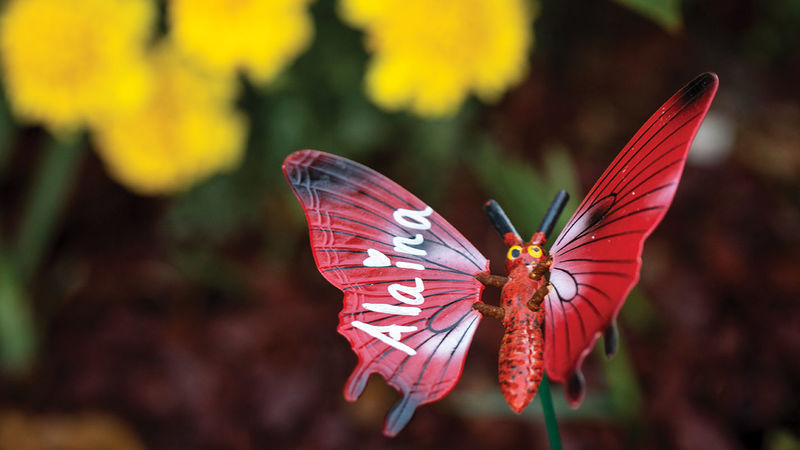Denise Foote was out shopping for Valentine’s Day treats for her kids when the killing began.
She wanted to make a big white-chocolate-chip cookie — her kids’ favorite — in the shape of a heart. She picked out the ingredients at the Walmart in Parkland, Florida, and nabbed some candies, too, planning to put them in little tins that her husband, Todd, had bought for the occasion. She pictured a festive evening ahead.
At that moment, a gunman walked through an unlocked gate in the chain-link fence around Marjory Stoneman Douglas High School.
The couple’s son Austin, a freshman at the school, was sitting at his desk in biology class.
2:19 p.m. School was almost out.
A campus monitor spotted the gunman heading for a three-story classroom building, Building 12, carrying a rifle bag. The monitor recognized the youth as a former student — a troubled kid he had once discussed as a potential school shooter at a staff meeting — but he did not call a code red, which would have put the school on lockdown. Instead, he radioed another campus monitor, who also recognized the gunman, and saw him enter the building. Still no code red. The failure to call for a lockdown was one of many security lapses that day, according to the January 2019 report of the state public safety commission that investigated the attack.
2:21 p.m. The first shots.
Firing his AR-15-style semiautomatic rifle into the hallway, the gunman killed students Martin Duque, Luke Hoyer and Gina Montalto. The gunfire triggered a fire alarm due to dust falling from the ceiling. He shot into classrooms, killing students Alyssa Alhadeff, Alaina Petty, Alex Schachter, Nicholas Dworet and Helena Ramsay. Someone called 911. The call got routed from one call center to another, slowing the response. Kids in a third-floor classroom of Building 12 heard gunshots and fled for the stairs, while students on the second floor ran into classrooms. Other kids on the third floor evacuated as they would for a fire drill, confused by the alarm.
Athletic director Chris Hixon, responding to the gunfire, entered the building, got shot and crawled behind a wall. He would be shot again, never to get up.
2:23 p.m.
More rounds fired, murdering student Carmen Schentrup. Assistant football coach Aaron Feis opened a door to the building and was shot dead. The shooter walked upstairs and killed cross-country coach Scott Beigel as he held open a classroom door so kids could take cover. The gunman next killed students Jaime Guttenberg, Cara Loughran, Joaquin Oliver, Meadow Pollack and Peter Wang. The only armed guard on campus failed to enter the building, opting instead to hide, according to the state report.
Austin Foote sat in class in the biology building, unaware of the carnage next door. He thought it was odd to hear a fire alarm since the school had already performed a fire drill that day. His class got up to evacuate, and when he stepped outside, he heard the gunfire. “I couldn’t tell where it was coming from,” he says. He makes a rapid, whizzing sound to describe it. His classmates ran for cover in the Junior ROTC building. He had no idea that on that day, February 14, 2018, five of his friends would not leave the school alive.
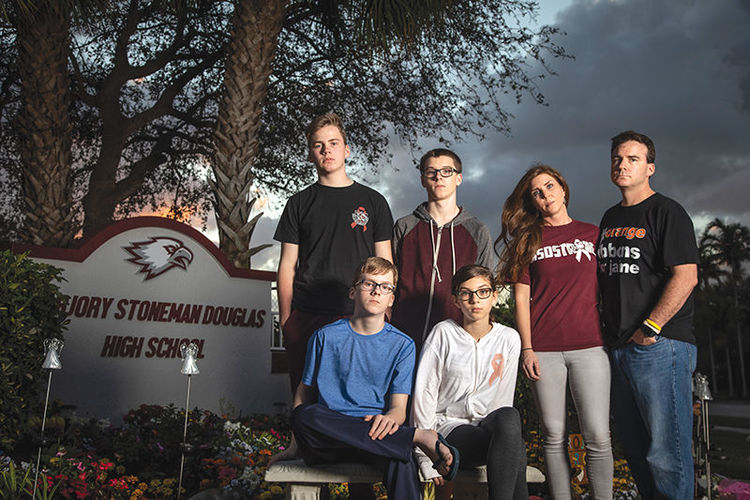 Photography by Benjamin Rusnak
Photography by Benjamin Rusnak
I meet with the Foote family in January of this year, a month before the first anniversary of the shooting. They’re sitting around the living room, a soothing oasis of teals and blues, with sea-themed artwork and an abundance of pillows — excellent building blocks for forts, the family’s four kids tell me. A tiger cat peeks out from under a chair. A sunny porch is decked out with Notre Dame paraphernalia, including a “Play Like a Champion Today” banner. It’s a man cave, Todd says. He got his MBA from Notre Dame in 2002.
School shootings are now a shared American experience that we all see and fear. They happen repeatedly, and we watch the news in horror. The Foote family has experienced it from the inside. They have seen the veneer of American safety stripped away.
They thought their son’s school was on top of security. It was not. They thought police would run toward the shooter. They did not. In the year following the massacre, their responses to the events of that terrible day, individually and as a family, took them to very different places. “It changes you as a person,” Denise says. Todd dramatically changed his politics, becoming a fiery activist. Denise switched jobs, needing more calm.
For 15-year-old Austin, only time will tell. In the weekend I spent with him, he wasn’t ready to say much about his experience. He loves animals, dreams of joining the Air Force, keeps busy with training. He is still coming to terms with the day his friends disappeared from his life. He is tomorrow’s America.
At Stoneman Douglas on that dreadful day, a campus monitor finally called a code red three minutes after the first gunshots. Deputies from the Broward County Sheriff’s Office arrived, but none entered the building to pursue the shooter, despite hearing gunfire — another failure, since it is standard protocol to move immediately toward gunshots, according to the state report. The killer dropped his weapon and left the building, joining a group of students running toward nearby Westglades Middle School. Denise and Todd had three children at the middle school. A code red had been called there, and the kids were huddled under tables, locked in their classrooms.
Denise heard sirens wailing as she walked out of the Walmart. “It was so loud, such a commotion,” she says. “As a mom, I had a bad feeling.”
The gunman swung by the same Walmart, where he bought a drink. Denise believes she may have been there at the same time. She drove home with that worried feeling in her gut. In her living room, she could still hear the sirens. “That was unusual since the hurricane windows usually block out sound,” she says. She texted Todd at work, and he reassured her. She turned on the TV to check for breaking news. None. She called her mother. Then she looked at the news again and saw it. Scrolling across the screen were the heart-stopping words: “Possible shooting at Marjory Stoneman Douglas.”
Panicked, she texted Austin, afraid that calling would put him in danger.
“Are you OK?”
“Yes,” he said. He was fine for the moment, hunkered down behind a Kevlar screen used for marksmanship. Doors locked, lights off.
Communications were slow; Austin recalls that it took a couple minutes for a text to go through. Denise called Todd and texted the kids at the middle school, but could reach only her daughter, hiding under a table. The gunman remained on the loose, pausing at a McDonald’s before moving on.
Todd rushed home, police cars flying past him. Austin stayed hidden until a SWAT team banged on the door. “Everyone started freaking out,” he says. “We had to walk out with our hands up and leave our backpacks. I was smart and grabbed my glasses and phone.” He texted his friend Alaina. No reply. Then he began walking home, helicopters hovering overhead. “A reporter stopped me and asked all these questions,” he recalls. “But I had no idea what had happened.”
More than an hour after the first gunshots, the killer was caught and arrested about two miles from the school. Identified as 19-year-old Nikolas Cruz, he had suffered mental health issues throughout his life. He killed 14 students and three staff members, and injured 17 others. Todd recognized him as the awkward kid who worked behind the counter at the dollar store.
'I thought,' says Denise, 'I can't be a mess in front of my kids, or they'll be a mess.'
Todd and Denise went to get their kids at the middle school. Mercifully the entire family was safe. Other parents gathered at the Marriott, waiting to hear the fate of their children on the worst day imaginable.
For the Foote family, the year to come was an evolution.
In their living room on a Saturday afternoon, the kids joke around, telling me how Ethan, now a freshman, is the brainy one. He once made an Oreo dispenser that popped out cookies for a quarter apiece. Another time, he built a go-kart, fashioning an engine out of an electric drill. “It was epic for 10 minutes,” he says. Then the engine died, stinking up the garage.
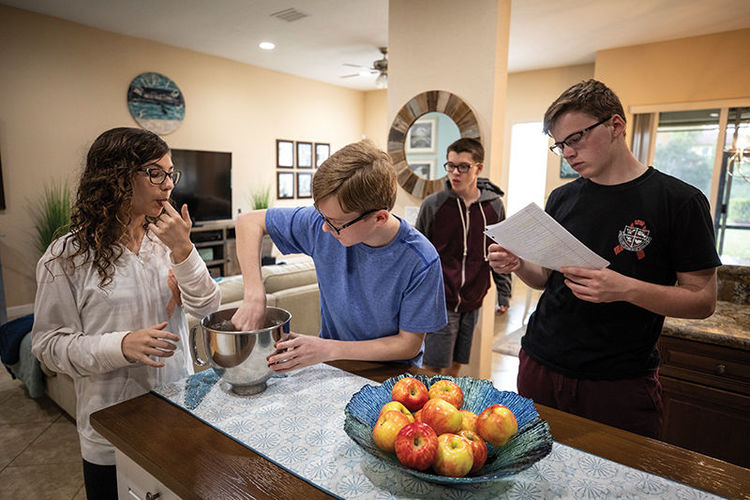
All the kids are creative. Jessica, a seventh grader, plays the French horn. Austin, now a sophomore, plays guitar. Eighth-grader Brandon plans to try out for his first school play, Legally Blonde. When talk turns to the shooting, Brandon and Jessica speak freely. Jessica says she advised a friend to play dead if a gunman came. “No one was allowed to leave the room,” she says. “We had to pee in cups.” Brandon recalls hearing the faint sound of gunshots from his classroom. Ethan, who was also at the middle school, remains silent.
Austin is mostly quiet, too. He was especially close to Alaina Petty, one of the first students to be shot. “They saw each other six days a week,” says Todd. Both were in Junior ROTC, and they often did activities together. Austin learned of Alaina’s death the morning after the massacre. The night before, he and his friends had been texting, checking to see who was still alive. Alaina had not replied.
Todd wondered how to console his son after the atrocity. “You want to take the pain off your kid, but what can you say? What is a dad supposed to say to his son after five of his friends were just murdered at school?” Austin kept looking at cellphone pictures of his friends, saying, “Dad, look, this was just a few days ago.” In one, he and Alaina were all smiles. “They’re gone,” Austin said in disbelief. Todd told him, “I’m sorry, buddy. When you want to talk about it, I’m here.” Therapists volunteered their services, and Austin went to see one, but wasn’t ready to talk.
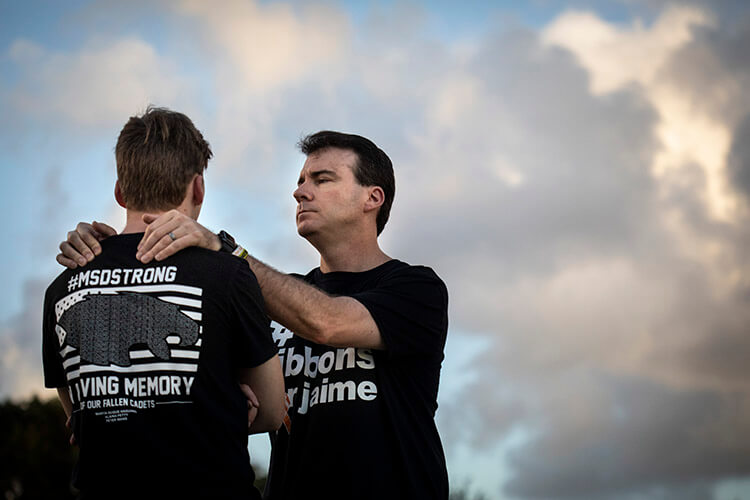
Todd says he “flipped a switch” after talking to Austin. He had been horrified by shootings in the past, but then had gone back to his life. This time, he felt a call to fight. He sat down at his computer, furiously typing up an uncharacteristic Facebook post. “I used to always be really careful with what I said,” he notes. “No more. I just let loose.”
In the lengthy post, the lifelong Republican wrote, “You can’t imagine how hard it is to try to console your teenage son who has lost so much. A child who should be thinking of girls and video games, rather than crying about these senseless losses and having to wait for school to start, only to know the chairs of his friends will forever remain empty. . . .
“It’s easy to sit from afar and send happy wishes, hugs and prayers. This doesn’t work to fix this recurring, murderous cycle. Action is now required and sensible gun control MUST happen.”
That week, he realized that his new political views might cost him friends and family. It started when his uncle posted something on Facebook that infuriated and baffled him. It was a link to a story spouting conspiracy theories about the massacre. Known as “truthers,” such people claim that mass shootings are fake and that the grieving people in the news photos are actors.
Todd couldn’t believe it. He had just been texting with this uncle, who had sent a flurry of thoughtful notes, saying he was thinking of Austin. “He’d been telling me he was praying for me and asking what he could do to help,” Todd says. Yet at the same time, his uncle was promoting the idea that the shooting was a hoax. It made no sense. Todd “unfriended” and blocked him. Later, he felt incensed again when his brother posted that people, not guns, are to blame for violence. Todd confronted him, saying, “This is raw for me. I would love to stay brothers with you. But think about what you’re saying. What if something like this happened to your daughters?”
Denise, blue-eyed and soft-spoken, says she admired Todd’s passion but worried about his anger during those first few weeks. “I was afraid it was going to consume him. He was all-in, which was fabulous, but at the same time, I didn’t want this anger to disrupt his whole life.”
Todd decided to channel his pain and rage into activism, tackling the issues that had led to the tragedy, he says, including “guns, school security, mental health, heeding the warning signs of troubled youth.” But before he could get to work, he had to do something unthinkable with his son. They needed to attend the funeral of Austin’s friend Alaina — on the day of Austin’s 15th birthday. “I just cracked walking through the church,” Todd says. “I cried like a baby.”
Back at work, he tried not to break down when people asked how he was doing. Austin soon headed back to the school — and to the scene of the crime. There, kids did art therapy and petted animals: horses, dogs, baby pigs and a llama, “or maybe it was a goat,” Austin says with a smile. As a cat lover, he adds, “They should have had cats. There’s such a stereotype against cats.”
Todd and Denise started calling state and local lawmakers, pushing for legislation on gun control and school safety. In March, they headed north to join their first-ever protest, the March for Our Lives in Washington, D.C. Todd laughs about how he had always thought marches were for hippies, not for him. Amid the sea of protesters, the couple felt inspired by the momentum of the youth-led movement. “We were so proud of our Parkland kids,” Denise says. “We feel like they’re our kids.” That same month, Florida passed a major gun reform and school safety bill, raising the age to purchase any firearm from 18 to 21, among other changes. The troubled Parkland teen had bought his semiautomatic rifle legally.
In April, Todd took another step, heading up a scholarship program for students at the high school, funded by the healthcare company where he is a senior director of finance. He hustled to meet with lawyers and learn how to launch a foundation. He wanted to get the first scholarships into seniors’ hands before they graduated. In May, he stood onstage at an awards ceremony and handed out $10,000 in scholarships. His company has since committed to giving $1 million over five years, he says, and he will supervise it.
'You want to take the pain off your kid, but what can you say?' says Todd. 'What is a dad supposed to say to his son after five of his friends were just murdered at school?'
That same month, Todd and Denise had another first, participating in a “die-in” at a local Publix store, lying on the floor to play dead in protest of the grocer’s political contributions. The night before the event, the couple lay in bed, wide awake. Neither one of them had done anything like this. Todd laughs as he recalls, “I didn’t really want to get arrested, or fired. I’ve never been radical.” Denise had the same concerns. But Todd had promised the father of one of the murdered students, Joaquin Oliver, that he would be there. At the protest, Denise met Joaquin’s mother and pledged never to forget her son. Lying on the floor, she says, “I cried the whole time.”
At home, Denise tried to keep things as normal as possible, even though she was having nightmares. “I thought, I can’t be a mess in front of my kids, or they’ll be a mess.” But life would never really be normal again. One night at dinner, while talking about a military ball that Austin planned to attend, Denise asked him, “Who would you like to ask to the dance?” He replied, “I can’t ask her.” It was Alaina. Denise wondered if he had felt much more for her than friendship.
It’s a chilly night following a hot day in Parkland, and a carnival welcomes visitors under a crescent moon in Pine Trails Park. In the wake of the shooting, 17 statues of angels stood here, in honor of the lives lost. Tonight, kids are wandering among the rides and retro cotton-candy stands, some shivering in shorts in T-shirts, others wearing jeans and coats. They’re smiling, eating hot dogs, hopping on rides. Little kids throw ping-pong balls at glass bowls, trying to win goldfish. In an amphitheater, a band sings an evocative cover of “Dreams” by Fleetwood Mac.
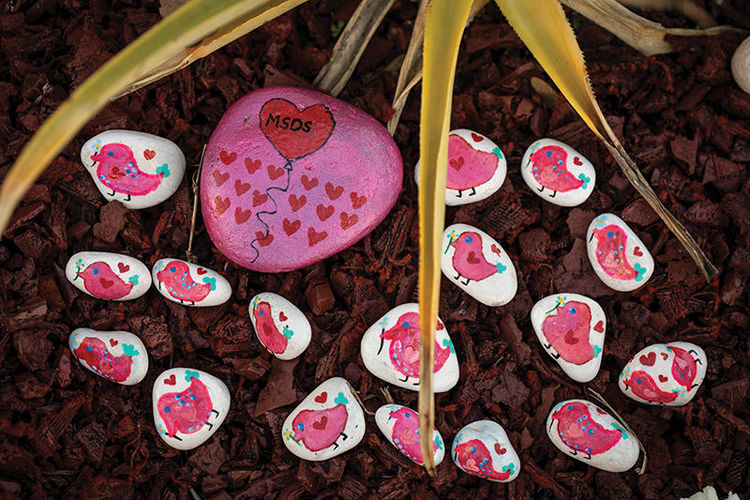
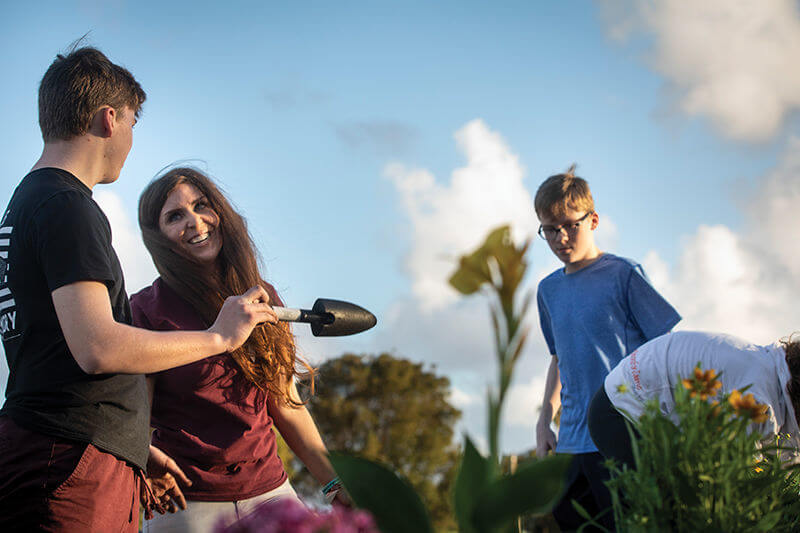
Standing on the dewy grass, Todd watches the young people having a fun night, like any other kids in any other town, yet not. He wonders what lies behind their smiles. “When I see these kids now, I think, what is their story? Were they at the high school that day? What did they see?”
He talks about the damage done by semiautomatic rifles. “When someone gets shot, you think of it as a clean wound, like in the movies. But these assault rifles just blow people to pieces. It’s not a clean hole in the chest. It’s a completely demolished kid. Some of these kids were shot nine, 10 times. There’s nothing left,” he says. “You have to think about what a shooting looks like — death and chaos and carnage.” Denise winces, sadness crossing her face. She says her brother once likened owning a gun to possessing the ring in The Lord of the Rings. “It becomes your ‘precious.’ People want to protect it,” she says. “They’re afraid someone will take it away.”
Denise and Todd both grew up around guns. Todd shot targets with his dad and grandfather in Arizona. “We had an annual Thanksgiving tradition, shooting old pop cans in the desert,” he says, noting that his father was a policeman and sniper. In her Oregon hometown, Denise says, “my granddad had a gun. He was a captain in World War II. All my friends were hunters. Kids would pull up at school with guns in the back of their pickups, but they were responsible.”
The Footes have never owned guns. They had never given much thought to the issue until it became personal.
The two first met in Arizona in their 20s; they went on a few dates and had a definite spark, but like a star-crossed couple in a Jane Austen tale, they misunderstood each other. She really liked him, but was too shy to express it. He thought her inability to talk to him meant they weren’t compatible. “She was smoking hot, but so quiet,” he says. They married other people and had kids, and both couples eventually divorced. Todd reconnected with Denise four years ago on Facebook, and they ended up getting married. The couple’s former spouses both live in Parkland and share custody of the children.
Both Todd and Denise were raised Mormon, but stopped practicing the religion as adults. “I believe in a higher power, but I don’t know what that exactly looks like,” Denise says. “I think the school shooting increased my belief in a higher power. I know that may sound odd, but I can’t believe family members will be separated from their loved ones forever. I truly feel that we will be reunited with our loved ones after we leave this earth.” For Todd, the shooting sparked a different response. “If anything, the massacre led me to doubt religion and a belief in God more,” he says, noting that he sees a disconnect in people who say they are religious but don’t support laws to protect kids from being gunned down at school.

The couple thought Parkland would be a great place to raise their family — it was known for being safe. They were shocked to learn about the security lapses at Austin’s school. Among the many failures listed in the state commission’s report, the classroom doors locked from the outside, not the inside, and many were unlocked as the shooter stormed the halls. At the same time, some of the bathrooms were locked due to a student vaping problem, so kids couldn’t seek cover in them. In addition, the school district didn’t allow police access to live campus video systems, hindering the response.
The list goes on. Glass windows in classroom doors left students in view of the killer. Only two of the 30 classrooms in Building 12 had “hard corners,” spots that can’t be seen through windows. The school had no active-shooter response policy, no written lockdown procedures. Staff members didn’t know or understand the criteria for calling a code red.
When contacted for comment, school officials referred me to the school district’s public information office, which did not respond. The Broward County Sheriff’s Office declined to comment.
Todd and Denise began pushing for school safety. They campaigned for school board candidates who shared that goal, including Lori Alhadeff, who’d lost her daughter, Alyssa, in the shooting. In August, Lori won her race. “I never used to pay attention to who’s on the school board, who’s the superintendent, the local councilman,” Todd says. “Now I know.” In October, he posted on Facebook, “Last month I left the Republican party and became unaffiliated. It’s liberating to not feel the impulse to doggedly defend a party, person, or position just because I’m attached to it.”
He tells me he doesn’t vote red or blue now, but orange, the color symbolizing gun safety.
On a scorching Sunday afternoon at Stoneman Douglas, Todd shows me where the gunman entered through the unlocked gate — another security failure. He points to Building 12, where the shooting occurred, and describes the sequence of events, talking through it floor by floor, naming every person who was killed. The empty and unused building, which has its own chain-link fence around it now, stands with boarded-up windows where bullets hit, a reminder of the awful day. It’s hard for Todd and Denise to pass the building. Todd makes a point not to drive past it. “But the students have to walk past it every day at school,” he says. “I feel like if they can do it, I should be able to.”
At a corner of the campus, a small crowd is gathering beside a garden of freshly planted flowers. A student, Tori Gonzalez, began planting the garden with her teacher and neighbor, Ronit Reoven, this past Christmas. “I wanted to remind people of kindness,” Tori tells me. Others have planted more flowers in recent weeks. Seventeen translucent angels line the garden, lighting up in rainbow colors at night.
Tori, a petite blonde with brown eyes and freckles, tells me that Joaquin Oliver was her “soul mate.” He had brought her Valentine’s flowers on the day he died. “He was above and beyond for me,” she says, describing their friendship and love. “I see so many little signs from him, letting me know that he’s there. We always said, ‘We’re gonna live all our lives together.’”
The crowd is here to celebrate the garden as well as a freshly painted school sign, thanks to the initiative of a parent who raised money to give the old sign, weatherworn and dirty, a new face. Todd and his family decide to make a quick trip to Walmart to pick up some flowers before the ceremony. At the store, we walk past a giant Valentine’s Day display bursting with red and pink hearts. Denise hurries by without turning her head. “I can’t look at it,” she says. It’s a reminder of life when it was more innocent, a year ago when she was planning her Valentine’s evening for the kids. We pick out little pots of orange, yellow and red flowers and head back to the school.
At the garden, parents of students who were killed in the shooting visit with other community members. They mingle and hug, wearing T-shirts with sayings such as “Douglas Strong,” and, “It’s not a left or right thing, it’s a life or death thing.” They discuss how Broward County Sheriff Scott Israel has just been suspended, following nearly a year of criticism over how his office responded to the massacre. Todd and Denise talk with Alaina’s parents, Ryan and Kelly Petty. Mitch Dworet, whose son Nick was killed, while his son Alex was injured, wears a black shirt emblazoned with a photo of Nick kissing his girlfriend. A star swimmer, Nick was set to go to the University of Indianapolis on a full scholarship when his life was cut short. Mitch shows me a fresh tattoo on his inner arm — an image of his son swimming, coming up for a breath of air in sparkling blue water. Mitch recalls how Nick wowed the Indianapolis coach when the two first met. “He impressed him with his eating skills,” he manages to joke. “Nick could eat.” Standing in the shadows as the sun begins to dip, Mitch smiles as he shares memories of his son, but his pain is palpable. “Nick was a leader, a dreamer and a lover,” he says.
Over dinner at a coal-oven pizza restaurant with the windows open to the cool evening air, the Foote family discusses what they might do this year on Valentine’s Day. Denise and Todd plan to take the day off. Her parents are coming in from Arizona. Austin says he might go to school that day, noting that there will be community service projects. “I think I should be there,” he says. They talk about the past year and the changes in their lives.
“For me, there is an underlying sadness now, something deep down,” Denise says. “It took away that innocence. You’re not as carefree. You know that your kids aren’t safe, and that the people who are supposed to look out for them might not be doing so.” Denise, who worked as a neonatal nurse in an intensive care unit at the time of the shooting, says that in the months that followed, the daily stress and tragedy of the job became too great, especially when preemies were born with deadly problems and drug addiction. She now spends her days giving IV infusions, which she finds more peaceful.
She describes the aftershocks of the massacre that have come throughout the year. She recalls how she was doing an infusion when she heard the news that 12 people were gunned down in a California country music bar back in November. Her hand had started shaking. “I realized I couldn’t control my body. I thought, if I feel this way, how are these young people feeling?” Activism has helped her feel like she is working toward change in the future, she says. She wants parents to understand that they can get involved, starting with checking on the safety of their children’s schools. “We just don’t want it to happen to anyone else,” she says.
For Todd, the experience has been an awakening. “These shootings happen so often now, it’s not shocking anymore. It’s in the news a day or two, then it fades. People need to realize that after the cameras leave, the trauma remains. When the headlines stop, that’s when the pain, anger and fury starts.” His eyes flash as he talks about it. “It made me say, this is unacceptable. This has to change. I don’t want to hear about thoughts and prayers. Let’s do action.”
Abby Pesta, a former intern with this magazine, has written for The Wall Street Journal, The New York Times, The Atlantic and Newsweek. She is the author of The Girls: An All-American Town, a Predatory Doctor, and the Untold Story of the Gymnasts Who Brought Him Down and coauthor of How Dare the Sun Rise: Memoirs of a War Child.
